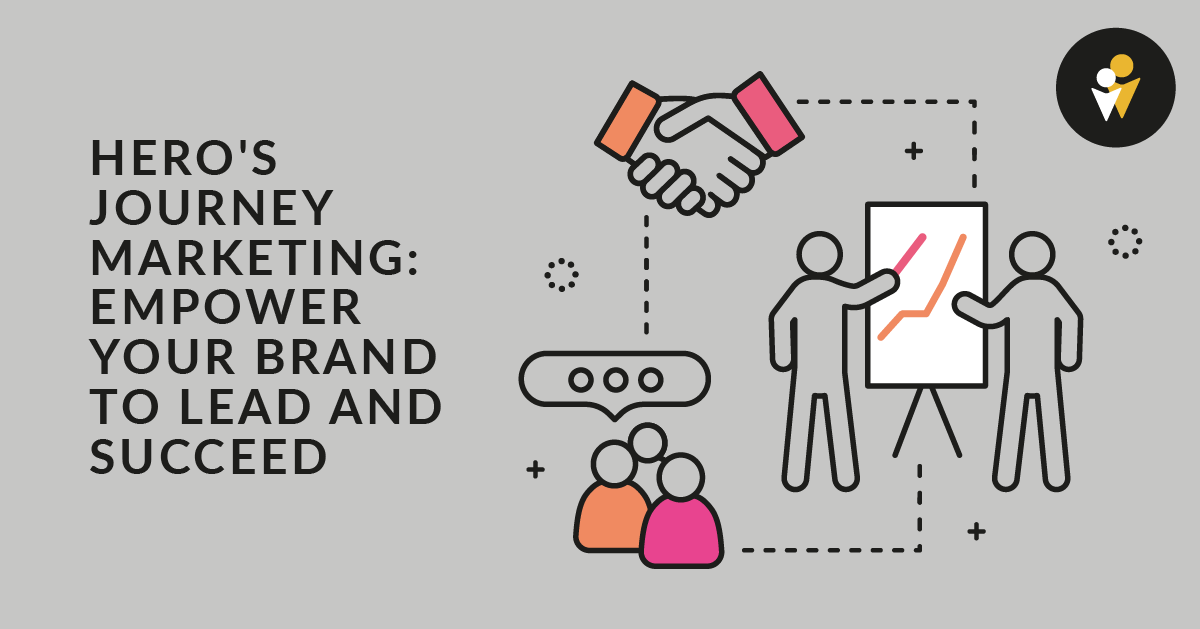Structuring your marketing content strategy with the hero’s journey storytelling method will empower your brand to lead in your industry and your company to succeed in its goals. Beyond an entertaining adventure, hero’s journey marketing allows your potential clients to see themselves as the Hero in your branded content. You can curate a fail-proof guide that leads them from online problem-solver to happy customer. This post will further explain what hero’s journey marketing is, how to develop and apply your Hero’s story, and more.
In the 90s, author Joseph Campbell published a guide for authors writing stories that champion their main character. The success of the most iconic adventure stories, such as Lord of the Rings, is attributed to the hero’s journey storytelling method. Your ideal customer might not be a Hobbitses on an epic quest, but throwing the One Ring into the fiery pits of Mordor might be the marketing equivalent of your customer finding the very best in compliance solutions.

What is Hero's Journey Marketing?
More recently, marketing genius, Robert Rose, mapped a way to apply the hero’s journey method to a content strategy. The concept is much the same, but the terms are not intuitive to marketing. However, this framework translates seamlessly into your content strategy. By casting your customers as your Hero, your content empowers them to face challenges and ultimately succeed. Your role as a brand is not to be the hero but to guide your Hero through their journey, providing solutions to their problems along the way.
How to Apply the Hero's Journey to Brand Storytelling
The stages of the hero’s journey are summarized as follows:
Act 1: Begins with the day-to-day tasks, before the hero experiences a catalyst of change.
- “The Call to Action”—Something happens in the hero’s life that creates a need for change or a solution.
- “Refusing the Call”—The hero tries to ignore the need for change or a solution and experiences the consequences.
- “Enter the Mentor”—A trusted confidant enters the story to assist the hero in accomplishing their mission.
- The Hero comes to a “Crossroads”—The hero must decide to leave the comfort of normal life to pursue the adventure and find the solution to their new need or problem.
Act 2: The hero chooses to pursue the solution and undergoes a period of transformation.
- “Test and Challenges” —Stepping away from home presents drama and conflict for the hero. Without conflict, the story would not be worthwhile.
- “Approach to the Center of the Unknown”—Describes the ambiguity of figuring out where the hero will find their solution and navigating the new-to-them path.
- “The Ordeal” —How the journey to their solution unfolds, for better or worse.
Act 3: In “The Return”, the hero leaps the proverbial chasm and takes hold of their goal.
- “The Reward”—Through dangers untold and hardships unnumbered, the hero faces down the Goblin King and wins her brother back! In other words, the journey pays off.
- “The Road Back”—The hero creates a new sense of normal with their newfound solution.
- Finally, the hero returns home, and everyone they left behind to pursue their goal hears of their epic adventure, setting an example or precedent for similar challenges in the future.
Using the Hero’s Journey in Marketing
Storytelling makes marketing so much more exciting. There does not need to be a Bridgerton-level of drama, conflict, and emotion, but demonstrating true-to-life scenarios in your content will help your hero realize you truly mean to help people, not just sell a product.
PIC breaks down the literary hero’s journey into a marketing content strategy—the Hero Mission Strategy—with six chapters:
Awareness and Engagement
- Encompasses life before, what might have caused the need to arise, and what problems your Hero might experience without the solution.
- Example: Before someone searches “best electrical generators for commercial use,” they might start with “what to do when your business loses power?” Your clients—or Heroes—must start somewhere, and often it’s a problem needing to be solved. Traditional marketing promotes the solution, but your Hero can’t go from chapter one to the end without some guidance.
Consideration and Building Trust
- Content becomes a step-by-step guide, helping your Hero navigate an industry with which they might not be familiar.
- Example: So much goes into installing an in-ground pool, but your Hero is considering taking on the project themselves. Many people do. To set your brand up as an authority in custom pool designs, publish content to help Polly-the-DIY-Pool-Guy get a full grasp of doing it themselves and where to turn when they get stuck.
Decision and Action
- Help your Hero navigate their options. Be a mentor. Hold their hand through the consideration and decision phases. Being a trustworthy mentor, or authority in your industry, means you know when to tell potential clients that yours are not the droids they are looking for. Set realistic expectations for navigating relationships in your industry after the purchase decision is made.
- Example: Think of potential clients you lose right before making the deal. Why did they back out at the last minute? Three main culprits could be the price was too high, the timeframe you offered didn’t work for them, or the quality of your work—based on client reviews—was not what they were looking for. If they backed out for one or more of these reasons, your business did not meet their desired outcome. Build content at this stage to clearly articulate your understanding of the hero’s desired outcome and how you will meet or exceed expectations.
Implementation and Adoption
- Demonstrating what “right” should look like when your Hero makes their choice, even if they choose to work with another company. Transparency in content further establishes your brand as a trusted guide.
- Example: Once a Hero signs a contract, what should they expect from the business relationship? These pieces of content move your Hero through industry best practices, red flags of predatory behavior, and outcomes your business specializes in.
Retention and Loyalty
- Be very careful not to write content solely for potential clients. Nor should a marketing department only provide information to those who are already familiar with their brand. This stage includes content that would further enrich the lives of current patrons.
- Example: Publish educational content for your existing clients. Explain how to keep their newly painted house in tip-top condition or provide winter maintenance tips for your industrial-sized generators. Being an authority does not end with the purchase; your Heroes are your Heroes even after they become your clients or customers. Demonstrate gratitude to your past customers with information they can use after the fact.
Advocacy and Expansion
- What is next for your clients? Maybe a pillar of your company is consistency. Build on this idea by developing content that explores the benefits of return business or plans for the future.
- Example: Seamlessly incorporate your up-sell strategy through more storytelling. Gandolf didn’t abandon Bilbo after their return from Misty Mountain. He remained in business to assist the next generation, staying top-of-mind with his magical firework displays until he was needed again. You can create raving fans of your business by recognizing and exploring opportunities to continue supporting your heroes.
Identifying Your Brand as the Guide for Your Hero’s Journey
Transforming your brand from a semi-truck into the leader of the Autobots might seem like science-fiction. The key to setting your brand up to be your ideal customer’s guide, or mentor in the story, is to be genuinely helpful. You must know your Hero to find out what motivates them.
Recognizing Your Hero’s Traits
After you’ve defined your Heroes, marry their desire for your business with your brand’s core values. What sort of Hero would prize durability? Likely a Hero who is greatly inconvenienced if the product were to break and would find great value in one that did so less often. They might focus on a single task for a long period of time and hold a trait of diligence, be detail-oriented, and have a no-nonsense attitude. Match your Hero’s traits to your core values and approach your storytelling from that perspective.
Does Hero’s Journey Marketing Work? Measuring the Impact of Your Hero’s Story
This framework taps into human psychology by engaging customers on an emotional level. By positioning your brand as the guide and your customer as the Hero, you help them feel understood and empowered. This storytelling technique fosters a stronger connection between your brand and your audience, leading to increased loyalty and advocacy.
Pay attention to the content pieces that receive the best reception, highest click-through rate, highest engagement time, etc. Read through the comments and keep up with the conversation. Are people throwing tomatoes at your performance? Track the results of your storytelling just as you would a major marketing campaign or advertising strategy.
No feedback is feedback. Continue to adjust your content and story until your message resonates with the right heroes.
Hero’s Journey Marketing Transforms Brand Storytelling and Customer Engagement
Challenge your marketing strategy to guide your ideal client through the twists and turns of your industry by taking a mentor approach. Adopting the hero’s journey marketing strategy means you shift the focus of your content from depicting your business as the sole provider of best-ever services to an infinitely helpful resource people trust to turn to for help.
PIC “Walks With You,” the marketing Hero, on your journey to stronger strategies and content that works. We take you step-by-step through applying our Hero Mission Strategy to your specific brand. If you are ready for a trusted mentor to guide you, contact us today and schedule a consultation.















